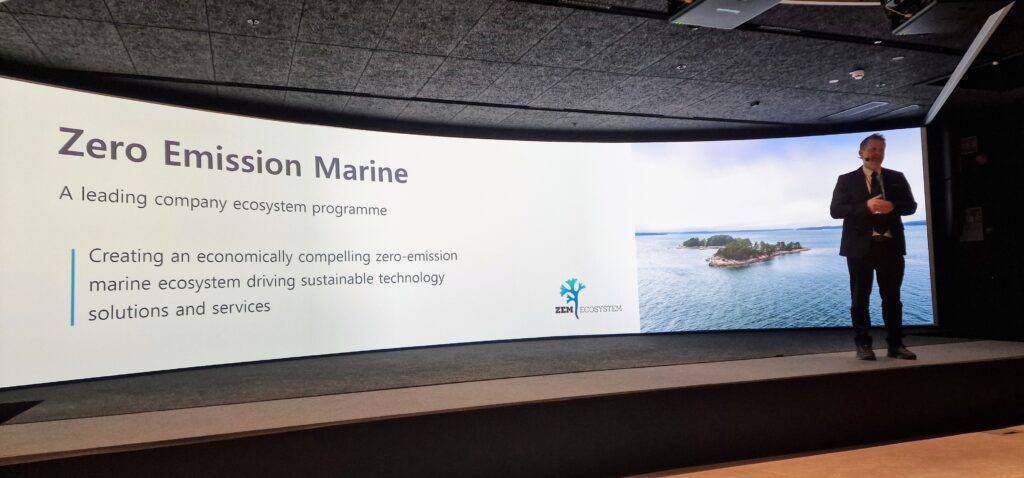Working together towards our common goal
The event was opened by Riku Mäkelä from Business Finland. Riku reminded the audience why ecosystem projects are important and how they are born: through a common mission. The green transition is a huge undertaking that requires the input of different players and a genuine willingness to work towards the common goal. Riku also reminded that the deadlines for the partnership model funding calls are 13 April and 13 September.
Meyer Turku’s NEcOLEAP ecosystem project was presented by Ilkka Rytkölä from Meyer Turku. Jonas Spohr, Åbo Akademi, Ari Niemelä, Meyer Turku, Henna Maula, Turku University of Applied Sciences and Mika Luimula, Turku University of Applied Sciences presented the projects related to NEcOLEAP. In his presentation, Ari Niemelä pointed out the important responsibility of engineers in stopping climate change, as the green transition requires a wide range of new technologies.
Kenneth Widell, project manager of Wärtsilä’s ZEM ecosystem, explained the Zero Emission Marine roadmap and what kind of partners and expertise Wärtsilä is looking for to join the ZEM ecosystem. A key aspect of ZEM is to make the green transition economically viable. The day’s panel discussion also focused on the same topic from the perspective of maritime value chains.
In addition to Wärtsilä and Meyer Turku, Teemu Kyläkallio from Rauma Marine Constructions (RMC) spoke about their Decatrip project, in which they are planning a carbon-neutral route between Turku and Stockholm.
Maritime value chains are key

The panel discussion focused on the green transition and value chains in the maritime industry. The panel was moderated by Tapani Mylly from Turku Business Region. The panelists were Kenneth Widell, Wärtsilä, Ilkka Rytkölä, Meyer Turku, Teemu Kyläkallio, RMC, Harri Salama, Royal Caribbean and Kim Salmi, Helsinki Shipyard.
The panel started with a discussion on how to bring green solutions on board. The answer is not simple and each actor in the value chain have their own challenges. But one thing is certain: the importance of collaboration is even more important as the building process of a vessel involves many subcontractors, partners, and suppliers, each with their own decarbonisation goals.
In the context of building a new vessel, the panel highlighted the fact that the solutions to enable the green transition are still expensive at present. When considering which solutions to include in vessels under construction, the lifecycle of 20-30 years must be considered, combined with the fact that technologies are developing several times over the lifecycle of a vessel.
“It is important to assess what the end customer is willing to pay and what is the driving force that makes the end customer willing to commit to the green transition,” Harri Salama commented.
Harri Salama, Royal Caribbeam
The positive thing for the Finnish marine industry is of course that Finnish shipyards now have a great opportunity to be at the forefront of driving the green transition forward.
The cost of green transition
Currently, demand for green transition comes from both consumers and regulation. In general, policymakers and business leaders are well-oriented towards promoting the green transition. For the green transition to happen, it must also be economically viable. The challenge is to find the best possible balance between demand and supply – green technologies must be a genuinely beneficial option to the end user.
The panelists repeatedly used the “carrot and stick” analogy. The stick can be seen as regulation and legislation, which are already an essential part of the green transition. With regulation, the need for the green transition in maritime will also increase and it will also make it easier to find the so-called carrot, i.e. the incentive. The panelists agreed that financial support is needed at the development stage to get things going. However, in the long term, it is not sustainable if the green transition would rely on subsidies alone.
An incentive must be found
Making sustainable solutions attractive means finding an incentive. Marketing and the way how sustainable solutions are sold are important elements. The panel noted that companies now need metrics, for example from the IMO (International Maritime Organization), to help them make decisions about the future.
So, what are the players that should be driving the change? The common consensus among the panelists was that responsibility lies with everyone – businesses, customers, consumers, public authorities, and policymakers.
“We cannot push the responsibility away; we all have a responsibility. It is important to build a roadmap on how to achieve the green transition step by step,” said Kenneth Widell.
Kenneth Widell, Wärtsilä
The will for the green transition is very high among businesses and people are excited about the challenges it will bring. All in all, the green transition requires common effort and a lot of new innovations. Projects such as Zero Emission Marine are an important part of making the decarbonisation of the marine industry a reality, involving the whole ecosystem and finding profitable solutions by sharing our knowledge and innovating together.
Funding opportunities available

MaritimeTech concluded with a review of potential funding opportunities and a presentation of various ongoing development projects in the Finnish marine industry. The gaps in the ecosystem projects of Wärtsilä and Meyer Turku were also discussed, i.e. where partners are particularly needed at the moment.
Regarding the ZEM project, Kenneth highlighted the production of green fuels, which is not a core competence of Wärtsilä. ZEM is looking for new concepts for the production of renewable and alternative fuels, without forgetting other areas such as new technologies, automated and optimised operations, and outcome-based business models.
Thanks to Turku Business Region and all the participants, there were almost 70 of you on-site to listen and network! Wärtsilä, Meyer Turku, Rauma Marine Constructions, Business Finland, and universities challenge companies to discuss cooperation and projects. You can contact the ZEM ecosystem at any time by submitting your contact details via the contact form or by sending an email to zem.ecosystem@wartsila.com.

